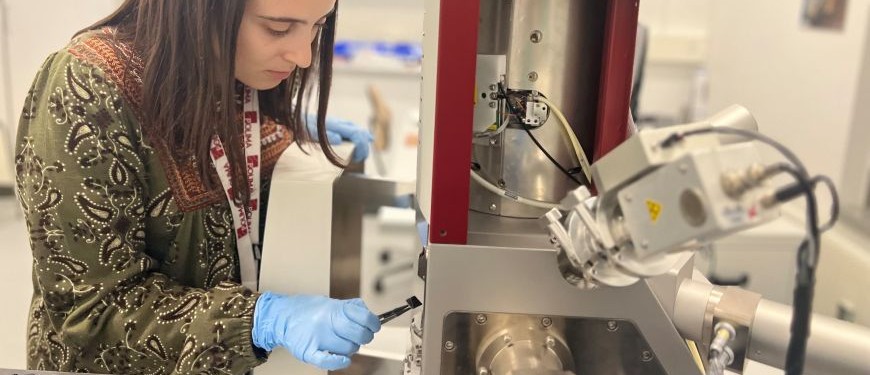Research Focus
In the Cathodoluminescence Laboratory, we investigate how materials emit light when excited by a focused electron beam—a process that reveals detailed information about their optical, electronic, and structural properties at the nanoscale.
Our work focuses on a wide range of materials, including 2D semiconductors, quantum emitters, plasmonic structures, and van der Waals heterostructures. By using cathodoluminescence, we can probe:
- Defect-related and band-edge emission, offering insights into the quality, purity, and local electronic environment of quantum materials.
- Nanoscale excitation and recombination pathways, helping us understand how excitons, plasmons, and other quasiparticles behave under localized energy input.
- Polarization and angular characteristics of light emission, which reflect the symmetry and electromagnetic environment of the emitting structure.
- Strain-dependent optical responses, using our integrated straining cell to study how mechanical deformation alters emission energies, spatial localization, and light-matter coupling.
- Low-temperature CL, with our cryogenic stage enabling the resolution of sharp spectral features and temperature-sensitive processes.
The unique advantage of electron-beam excitation lies in its ultrahigh spatial resolution and the ability to excite optical modes inaccessible to photons—making it a powerful complement to photoluminescence techniques and essential for exploring nanophotonic and quantum-optical phenomena with high precision.
State-of-the-Art Instrumentation
At the heart of the lab is a scanning electron microscope (SEM) operating at 0.1–30 kV acceleration voltages, coupled with a Delmic cathodoluminescence add-on system, offering an unparalleled suite of imaging and spectroscopic capabilities:
- Cathodoluminescence Spectroscopy: Enables broadband optical emission analysis with nanometer-scale spatial resolution.
- Fourier Imaging and E–k Mapping: Measures angular radiation patterns and momentum-resolved emission, providing deep insight into how light is emitted from nanostructures.
- Polarimetry: Captures the polarization state of emitted light, revealing information about dipole orientations and anisotropies.
- Cryogenic Stage: Allows temperature-controlled measurements down to liquid nitrogen temperatures, making it possible to observe fine spectral features, suppressed phonon interactions, and low-temperature phase phenomena.
- Integrated Straining Cell Compatibility: Our custom-built straining device can be mounted directly inside the SEM chamber, allowing us to apply precisely controlled uniaxial strain to 2D materials during CL measurements. This capability unlocks the ability to dynamically tune optical properties under electron excitation, offering an advanced route to study strain-engineered emission phenomena.
- Hanbury Brown and Twiss Interferometry (HBT): A custom-built setup enables photon correlation experiments in the CL regime, allowing investigation of quantum emission statistics at the nanoscale.
Why It Matters
Cathodoluminescence provides a powerful, high-resolution alternative to optical excitation, capable of probing how light emerges from deep within materials—layer by layer, structure by structure. It grants access to sub-wavelength details, often inaccessible through traditional optical techniques, and offers new insights into the interplay between structure, defects, and light emission.By combining electron-beam excitation with angular, spectral, and polarization-resolved detection, and integrating strain control and cryogenic environments, our lab creates the ideal platform for exploring the quantum optical behavior of materials at the nanoscale.
Whether you're mapping the local photonic environment, engineering directional emission, or uncovering new light-emission mechanisms, this lab stands as a unique gateway into the frontier of electron-driven nanophotonics and quantum materials science.
